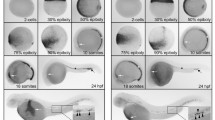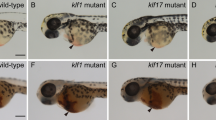Abstract
Heterotrimeric guanine nucleotide-binding regulatory proteins (G proteins) function as signal transducers and control many different physiologic processes. G proteins can be grouped into four families: Gs, Gi, Gq and G12. Gα13 belongs to the G12 family. In zebrafish, there are two isoforms of Gα13: Gα13a and Gα13b. We show here that knockdown of Gα13b in zebrafish results in hematopoietic and angiogenic defects. The Gα13b morphants don’t show complete loss of expression of gata1, pu.1 or flk until 35 hpf suggests that Gα13b is closely related to the development of hematopoietic cells. Further studies reveal that blood cells and vascular endothelial cells have undergone apoptosis through a p53-dependent pathway in Gα13b-depleted embryos. Injection of p53 morpholino could partially rescue the phenotype of Gα13b morphants. These data possibly demonstrate a new role for Gα13 in cell survival.






Similar content being viewed by others
References
Gilman AG (1987) G proteins: transducers of receptor-generated signals. Annu Rev Biochem 56:615–649
Bourne HR, Sanders DA, McCormick F (1990) The GTPase superfamily: a conserved switch for diverse cell functions. Nature 348:125–132
Simon MI, Strathmann MP, Gautam N (1991) Diversity of G proteins in signal transduction. Science 252:802–808
Gu JL, Muller S, Mancino V, Offermanns S, Simon MI (2002) Interaction of G alpha(12) with G alpha(13) and G alpha(q) signaling pathways. Proc Natl Acad Sci USA 99:9352–9357
Offermanns S, Mancino V, Revel JP, Simon MI (1997) Vascular system defects and impaired cell chemokinesis as a result of Galpha13 deficiency. Science 275:533–536
Kimmel CB (1989) Genetics and early development of zebrafish. Trends Genet 5:283–288
Shivdasani RA, Orkin SH (1996) The transcriptional control of hematopoiesis. Blood 87:4025–4039
Herbomel P, Thisse B, Thisse C (1999) Ontogeny and behaviour of early macrophages in the zebrafish embryo. Development 126:3735–3745
Bennett CM, Kanki JP, Rhodes J, Liu TX, Paw BH, Kieran MW, Langenau DM, Delahaye-Brown A, Zon LI, Fleming MD, Look AT (2001) Myelopoiesis in the zebrafish, Danio rerio. Blood 98:643–651
Detrich HW 3rd, Kieran MW, Chan FY, Barone LM, Yee K, Rundstadler JA, Pratt S, Ransom D, Zon LI (1995) Intraembryonic hematopoietic cell migration during vertebrate development. Proc Natl Acad Sci USA 92:10713–10717
Brownlie A, Hersey C, Oates AC, Paw BH, Falick AM, Witkowska HE, Flint J, Higgs D, Jessen J, Bahary N, Zhu H, Lin S, Zon L (2003) Characterization of embryonic globin genes of the zebrafish. Dev Biol 255:48–61
Willett CE, Cortes A, Zuasti A, Zapata AG (1999) Early hematopoiesis and developing lymphoid organs in the zebrafish. Dev Dyn 214:323–336
Lin F, Sepich DS, Chen S, Topczewski J, Yin C, Solnica-Krezel L, Hamm H (2005) Essential roles of G{alpha}12/13 signaling in distinct cell behaviors driving zebrafish convergence and extension gastrulation movements. J Cell Biol 169:777–787
Lin F, Chen S, Sepich DS, Panizzi JR, Clendenon SG, Marrs JA, Hamm HE, Solnica-Krezel L (2009) Galpha12/13 regulate epiboly by inhibiting E-cadherin activity and modulating the actin cytoskeleton. J Cell Biol 184:909–921
Rekhtman N, Radparvar F, Evans T, Skoultchi AI (1999) Direct interaction of hematopoietic transcription factors PU.1 and GATA-1: functional antagonism in erythroid cells. Genes Dev 13:1398–1411
Hsu K, Traver D, Kutok JL, Hagen A, Liu TX, Paw BH, Rhodes J, Berman JN, Zon LI, Kanki JP, Look AT (2004) The pu.1 promoter drives myeloid gene expression in zebrafish. Blood 104:1291–1297
Kappel A, Schlaeger TM, Flamme I, Orkin SH, Risau W, Breier G (2000) Role of SCL/Tal-1, GATA, and ets transcription factor binding sites for the regulation of flk-1 expression during murine vascular development. Blood 96:3078–3085
Liu Y, Wada R, Yamashita T, Mi Y, Deng CX, Hobson JP, Rosenfeldt HM, Nava VE, Chae SS, Lee MJ (2000) Edg-1, the G protein-coupled receptor for sphingosine-1-phosphate, is essential for vascular maturation. J Clin Invest 106:951–961
Masuda Y, Takatsu Y, Terao Y, Kumano S, Ishibashi Y, Suenaga M, Abe M, Fukusumi S, Watanabe T, Shintani Y (2002) Isolation and identification of EG-VEGF/prokineticins as cognate ligands for two orphan G-protein-coupled receptors. Biochem Biophys Res Commun 293:396–402
Bagnato A, Spinella F (2003) Emerging role of endothelin-1 in tumor angiogenesis. Trends Endocrinol Metab 14:44–50
Leung T, Chen H, Stauffer AM, Giger KE, Sinha S, Horstick EJ, Humbert JE, Hansen CA, Robishaw JD (2006) Zebrafish G protein gamma2 is required for VEGF signaling during angiogenesis. Blood 108:160–166
Sumanas S, Lin S (2006) Ets1-related protein is a key regulator of vasculogenesis in zebrafish. PLoS Biol 4:e10
Shan D, Chen L, Wang D, Tan YC, Gu JL, Huang XY (2006) The G protein G alpha(13) is required for growth factor-induced cell migration. Dev Cell 10:707–718
Versteeg HH, Spek CA, Slofstra SH, Diks SH, Richel DJ, Peppelenbosch MP (2004) FVIIa:TF induces cell survival via G12/G13-dependent Jak/STAT activation and BclXL production. Circ Res 94:1032–1040
Adarichev VA, Vaiskunaite R, Niu J, Balyasnikova IV, Voyno-Yasenetskaya TA (2003) G alpha 13-mediated transformation and apoptosis are permissively dependent on basal ERK activity. Am J Physiol Cell Physiol 285:C922–C934
Wang RM, Zhang QG, Li J, Yang LC, Yang F, Brann DW (2009) The ERK5-MEF2C transcription factor pathway contributes to anti-apoptotic effect of cerebral ischemia preconditioning in the hippocampal CA1 region of rats. Brain Res 1255:32–41
Gomez-Lazaro M, Fernandez-Gomez FJ, Jordan J (2004) p53: twenty five years understanding the mechanism of genome protection. J Physiol Biochem 60:287–307
Kim MS, Lee SM, Kim WD, Ki SH, Moon A, Lee CH, Kim SG (2007) G alpha 12/13 basally regulates p53 through Mdm4 expression. Mol Cancer Res 5:473–484
Marine JC, Jochemsen AG (2005) Mdmx as an essential regulator of p53 activity. Biochem Biophys Res Commun 331:750–760
Summerton J (1999) Morpholino antisense oligomers: the case for an RNase H-independent structural type. Biochim Biophys Acta 1489:141–158
Robu ME, Larson JD, Nasevicius A, Beiraghi S, Brenner C, Farber SA, Ekker SC (2007) p53 activation by knockdown technologies. PLoS Genet 3:e78
Ekker SC, Larson JD (2001) Morphant technology in model developmental systems. Genesis 30:89–93
Westerfield M (1995) The zebrafish book: a guide for the laboratory use of zebrafish (Danio rerio), 3rd edn. M. Westerfield, Eugene, OR
Hyatt TM, Ekker SC (1999) Vectors and techniques for ectopic gene expression in zebrafish. Methods Cell Biol 59:117–126
Sumanas S, Gomez G, Zhao Y, Park C, Choi K, Lin S (2008) Interplay among Etsrp/ER71, Scl, and Alk8 signaling controls endothelial and myeloid cell formation. Blood 111:4500–4510
Link V, Shevchenko A, Heisenberg CP (2006) Proteomics of early zebrafish embryos. BMC Dev Biol 6:1
Serbedzija GN, Flynn E, Willett CE (1999) Zebrafish angiogenesis: a new model for drug screening. Angiogenesis 3:353–359
Jowett T, Lettice L (1994) Whole-mount in situ hybridizations on zebrafish embryos using a mixture of digoxigenin- and fluorescein-labelled probes. Trends Genet 10:73–74
Mo S, Song P, Lv D, Chen Y, Zhou W, Gong W, Zhu Z (2005) Zebrafish z-otu, a novel Otu and Tudor domain-containing gene, is expressed in early stages of oogenesis and embryogenesis. Biochim Biophys Acta 1732:1–7
Yamauchi H, Hotta Y, Konishi M, Miyake A, Kawahara A, Itoh N (2006) Fgf21 is essential for haematopoiesis in zebrafish. EMBO Rep 7:649–654
Acknowledgments
We thank Dr. Nobuyuki Itoh at Kyoto University Graduate School of Pharmaceutical Sciences for plasmids of flk, gata1, pu.1, Dr. Shanye Gu at the Institute of Neuroscience, Chinese Academy of Sciences, for plasmids transferring, and Dr. Wei Zhang for imaging assistance. We also thank Dr. Margaret Ragni at Department of Medicine in University of Pittsburgh for critical reading of this manuscript and making significant improvement. The authors declare no conflict of interests. This study was supported by the Natural Sciences Foundation of China (No. 30510521 to P. Song and XY. Huang; No. 2004CB117401 to P. Song) and by ICGEB Research Grant (CRP/CHN02-01 to P. Song).
Author information
Authors and Affiliations
Corresponding author
Electronic supplementary material
Below is the link to the electronic supplementary material.
Rights and permissions
About this article
Cite this article
Ye, D., Yang, Q., Li, Y. et al. Gα13 is closely related to hematopoiesis in zebrafish. Mol Biol Rep 38, 2685–2694 (2011). https://doi.org/10.1007/s11033-010-0411-9
Received:
Accepted:
Published:
Issue Date:
DOI: https://doi.org/10.1007/s11033-010-0411-9




